5 Ways Course Creators Can Boost Their Revenue (Besides Course Sales & Memberships)
Jesse Young El
What’s the easiest way to sell a $10,000 watch?
(Or a $10,000 course, for that matter).
The answer to this question will help you generate considerably more revenue than simply relying on course sales and memberships alone.
I’ll give you the answer in a bit.
But to appreciate and find value in the answer, we’ll first have to explore some additional revenue streams you can tap into to earn more money for your online course business.
In this article, we will discuss five of the fastest and easiest methods to implement.
Let’s go!
Method 1. Brand Deals and Sponsorships
If you have a popular course or membership, you can approach companies and offer to promote their products or services to your students in exchange for paid sponsorships and a commission on sales.
Once you’ve locked in a brand deal, very little work is required. Just find meaningful ways to plug your sponsors’ product or service into the content you’re already creating, such as course videos, YouTube videos, and newsletters.
It’s a great way to earn additional revenue while providing value to your students.
And in the long term, brand deals can prove to be extremely lucrative.
For example, In 2021, Ali Abdaal, a YouTuber and productivity instructor, generated $523,000 from brand deals alone!

Justin Welsh is another popular course creator who has generated significant revenue from brand deals.
Justin’s weekly newsletter “The Saturday Solopreneur” rakes in $3,400 per month in sponsorships.
And according to his sponsorship page, brand deal openings are currently booked out 12-14 weeks!
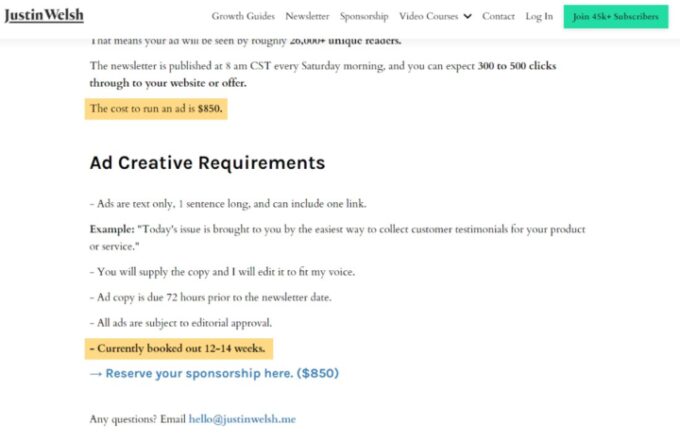
If you’re interested in pursuing brand deals, the best way to get started is by reaching out to companies that you think would be a good fit and pitching them your idea.
You can also try using platforms like Mavrck and Influence.co to connect with brands looking to collaborate.
Method 2. Sell Swipe Files, Templates and Cheat Sheets
You can also create and sell digital products that your students or members can use to save time and get better results.
These could be things like:
Swipe files:
A collection of the best examples in a particular field or niche.
Templates:
Pre-made templates or frameworks that can be used as a starting point for solving a problem.
Cheat sheets:
A distilled, concentrated guide that outlines key points or steps in a process.
To get started, simply create the digital product (or outsource it to someone on Fiverr) and then sell it to your students.
If you’re looking for an easy way to sell digital products, I recommend using the Gumroad platform.
Gumroad is a popular platform that makes it easy to sell digital products like swipe files, templates and cheat sheets.
They provide all the tools you need to get started, including a checkout system, payment gateways, and delivery of digital products.
Plus, they don’t charge upfront fees. Gumroad only makes money when you make money.
One company that’s successfully using this method is Wad Street, an online platform that offers courses on a variety of topics dealing with personal finance, wealth creation, and learning complex money concepts through entertainment and pop culture.
In addition to courses, they also sell templates, swipe files, and cheat sheets that their students can use to get started with wealth creation, pronto.
WadStreet uses a landing page on their website to promote and link to their courses and cheat sheets hosted by Gumroad.
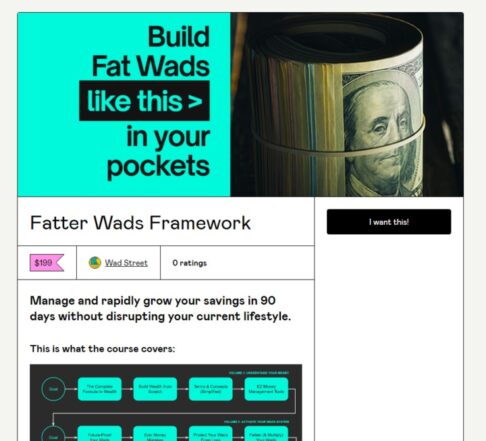
Easlo is a course creator who teaches innovative ways to leverage a popular productivity tool called Notion.
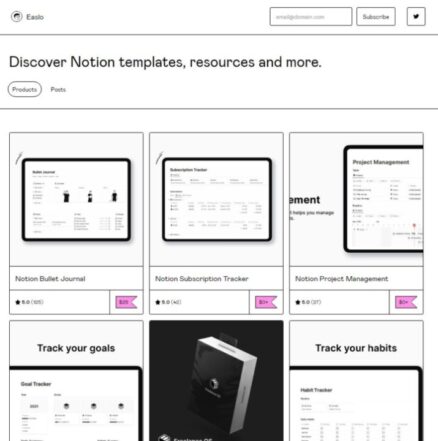
In addition to courses, Easlo offers 28 templates on Gumroad that his pupils use to get started with Notion for a variety of applications.
For him, this has turned out to be a lucrative strategy:
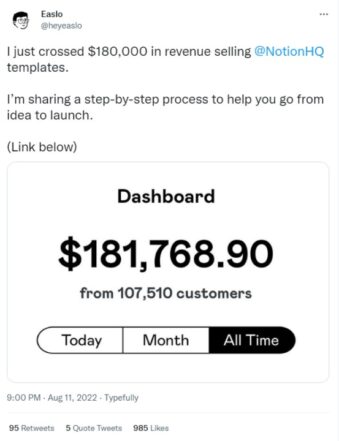
Method 3. Provide Consulting Services
If you have expertise in a particular area, you can provide consulting services to your students.
The key is to know how to package the service so it’s valuable for your students and profitable for you to carry out.
You can create consulting packages and sell them to your students or members. This is a great way to provide additional value and earn more money.
To get started, simply create a landing page or PDF explaining what services you offer, what the package includes, and how much it costs.
The packages you create should compliment the courses or membership you offer by addressing further questions or deeper problems that might arise.
When your package is ready, post it on your website or blog, promote it to your students, and find appropriate places within your courses to recommend it.
NOTE: Do not oversell these packages within your paid courses. Nothing is more annoying for your students than to be sold to within the courses that they’ve paid their hard-earned money for. Mention them sparingly and only in the few places they’ll be most appreciated.
Here are a few types of consulting services you can try:
- In-depth 1 hour call ($$$): charge $100 (or more) per call.
- 1-on-1 coaching ($,$$$): charge a premium for students to access you or your team
- Custom Roadmaps ($$,$$$): through a series of calls, help students map a course of action BEYOND what they’d get in your course
- “Do It For Them” service ($$$,$$$): Students agree with your methods and teachings — they just don’t have the time or patience to do it themselves. And a handful of your students will have the deep pockets to hire your team to do the work for them. Close the deal with them and get to work!
Method 4. Sell Branded Course-Related Merchandise
If you have a popular course and an engaged audience, you can sell branded merchandise to your students.
This is a great way to generate additional revenue and further establish your brand.
First, you have to come up with your brand statement.
Your brand statement is a single phrase, a declaration that sums up who you are as a brand.
Here are a few examples of excellent brand statements:
Coca Cola: “Refresh the world. Make a difference.”
Microsoft: “Empowering others”
Whole Foods Market: “Nourish people and the planet”
Once you’ve found a brand statement that truly reflects who you are, use it on EVERYTHING:
- your hats
- your t-shirts
- your website
- your alpine flasks
- your coffee mugs
- your business cards
- your email signatures
- your social media channels
- everything!
But, how do you get your brand statement on EVERYTHING?
Either partner with a Print-on-Demand (POD) Service or invest in the tech and create your own merchandise. Here’s how:
Partner with a Print-on-Demand Service
A Print-on-Demand (POD) service is a company that will print and ship your branded merchandise on demand (as in, when someone orders it).
This is a great option if you don’t want to deal with the hassle of printing, packaging, and shipping your own merchandise.
Fourthwall is a great company that will print and ship your branded merchandise on demand.
This is a great option if you don’t want to deal with the hassle of printing, packaging and shipping your own merchandise.
To get started, simply create an account with Fourthwall and select the products you want to sell.
They will handle all the printing and shipping for you, so you can focus on creating great courses and content!
With a POD service, you can quickly scale up to a variety of over 30 products like Tech YouTuber Marques Brownlee otherwise known as MKBHD.
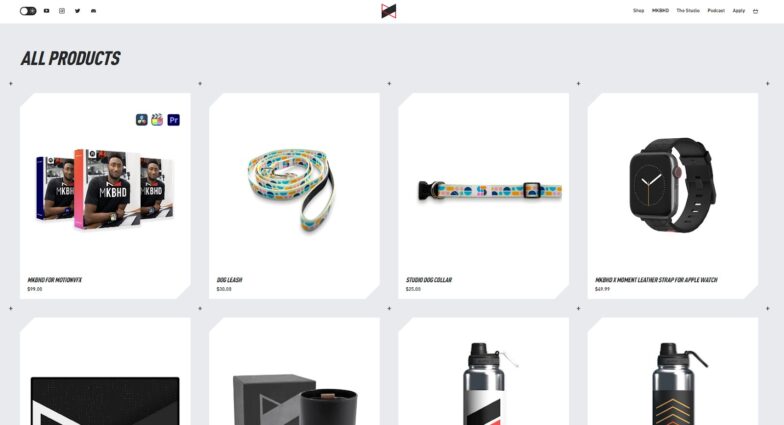
Or you can promote as few as 1 shirt design in 3 color options, like the course creators at Amexem.

Your scale is up to you, your brand, and what you feel is best for your students.
The main drawback of using POD services is that they keep a large chunk of your sales profits (and reasonably so, since they’re doing most of the work).
So, what if you wanted to keep most of the profits instead?
Invest in the tech and Print Your Own merchandise
If you don’t want to use a POD service, you can purchase your own printing equipment and you and your team can handle all the printing, packaging and shipping yourself.
This requires a slightly larger upfront investment, but it will pay off in the long run as you’ll get to keep most of the profits from each sale.
For most operations, all you’ll need are:
- A proper printer to print your design
- Cricut cutting machines to cut your design
- Materials/objects to apply your design to
A huge plus for this method of creating merchandise is that you don’t have to sit on large amounts of inventory.
You can create a few and keep on hand, or print whenever a new order comes in like POD services do.
Method 5. Earn Affiliate Commission on Sales of Other Course-Related Products
If you don’t want to create and sell your own branded merchandise, or you want to create even more revenue opportunities, you can generate additional revenue by promoting others’ products that are related to your courses.
You can do this by partnering with other companies and earning an affiliate commission on sales that you generate.
For example, if you have a professional development and networking course, you could promote digital business cards like this site does and earn a commission for every sale.
Or if you have a course or members who are concerned with being more productive coders or designers, you could recommend the best headphones to use to weed out distractions, like I did here.
If you think about it, this presents amazing opportunities. Nearly every product becomes an opportunity for affiliate commissions. And nearly all major retail chains have an affiliate program in place.
Walmart is a retail behemoth with nearly 11,000 stores worldwide.
They sell 120,000 items in stores and 35 MILLION products online.
Imagine if you could make a commission from anything Walmart sells.
You can.
Here’s how:
Just Google “walmart.com affiliate program”
You’ll be sent to the Walmart affiliate program landing page which looks like this:
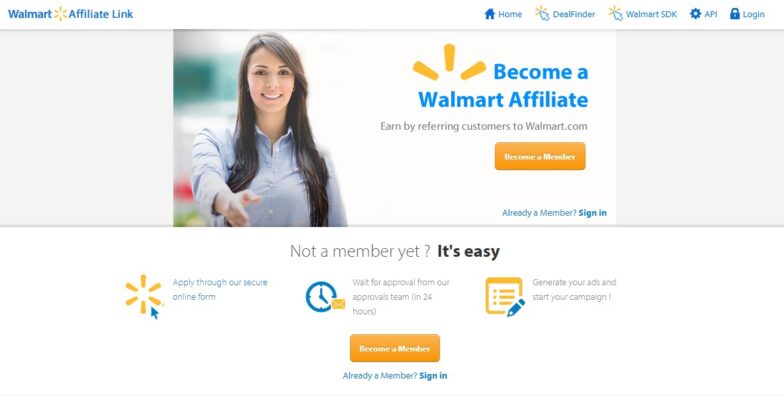
Then you can sign up for a free account, get your links and start promoting!
The best part is that there’s no limit to how many products or companies you can promote.
And this formula works for ANY retail company or product brand:
Just google “[store URL] affiliate program”
If they have an affiliate program, this formula will find it for you!
Ready to Earn Some Additional Revenue?
As you can see, there are a variety of ways you can generate additional revenue as a course creator.
You’re not limited to just course sales and memberships.
By expanding your business model and generating revenue from multiple streams, you can create a more sustainable business that will be less reliant on any one particular stream.
But here’s the icing on the cake.
Remember the question I asked at the beginning of this article?
These five methods build on the classic sales concept of answering “what’s the easiest way to sell a $10K watch?
The answer: Display the $10,000 watch next to a $50,000 watch.
In this metaphor, more $10K watches would be sold because by displaying them next to more expensive watches, customers suddenly have an idea of a perceived “deal” or “savings”. Selling the $10K watch alone would not create such a psychological effect.
More revenue would be made because people now have to consider the $50K watches.
In my personal experience with course sales and membership sites, revenue from the additional sources listed in this article generates even more course and membership sales for your brand.
How?
All these additional methods put more eyeballs on your courses, which leads to more sales in the future.
PLUS, these additional offers create a psychological effect of greater perceived value for your courses, making customers more likely to purchase your courses in the near future.
It’s like a revenue generating loop. Each revenue stream feeds the other.
Pick one of these that you feel would be easiest to implement and most valuable to your students.
You won’t regret it.